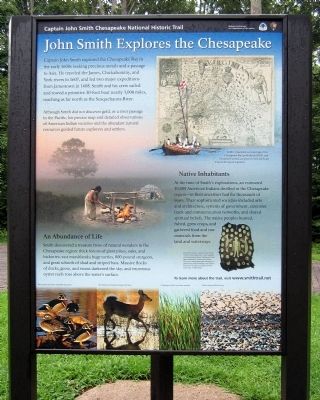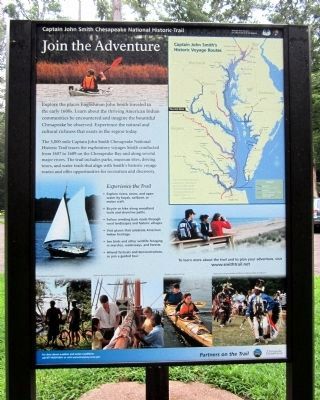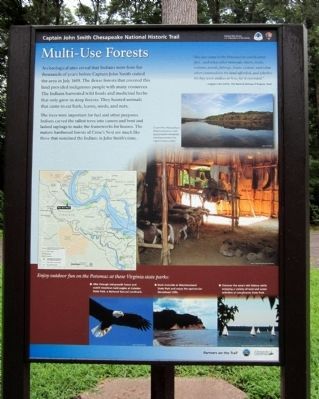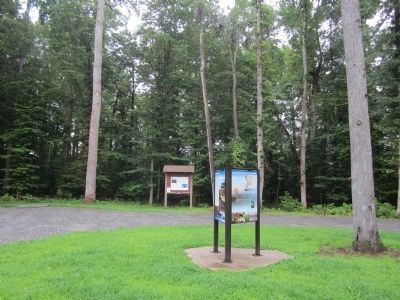Near Stafford in Stafford County, Virginia — The American South (Mid-Atlantic)
John Smith Explores the Chesapeake
Captain John Smith Chesapeake National Historic Trail
(panel 1)
Captain Smith explored the Chesapeake Bay in the early 1600s seeking precious metals and a passage to Asia. He traveled the James, Chickahominy, and York rivers in 1607, and led two major expeditions from Jamestown in 1608. Smith and his crew sailed and rowed a primitive 30-foot boat nearly 3,000 miles, reaching as far north as the Susquehanna River.
Although Smith did not discover gold, or a river passage to the Pacific, his precise map and detailed observations of American Indian societies and the abundant natural resources guided future explorers and settlers.
Native Inhabitants
At the time of Smith’s explorations, an estimated 50,000 American Indians dwelled in the Chesapeake region—as their ancestors had for thousands of years. Their sophisticated societies included arts and architecture, systems of government, extensive trade and communication networks, and shared spiritual beliefs. The native peoples hunted, fished, grew crops, and gathered food and raw materials from the land and waterways.
An Abundance of Life
Smith discovered a treasure trove of natural wonders in the Chesapeake region: thick forests of giant pines, oaks, and hickories; vast marshlands; huge turtles, 800-pound sturgeon, and great schools of shad and striped bass. Massive flocks of ducks, geese, and swans darkened the sky; and enormous oyster reefs rose above the water’s surface.
(captions)
(upper right) Smith‘s remarkably accurate map of the Chesapeake Bay (published in 1612), and his spirited written accounts of a lush landscape inspired European migration.
(lower right) Decorative shells—such as those found on this ceremonial robe—were valuable in the American Indians’ trading network that extended for hundreds of miles. This robe (which may have belonged to paramount chief Powhatan) was crafted from four elk skins and adorned with more than 17,000 shells.
(bottom) Wood ducks and other waterfowl flourished; The forests and lowlands teemed with deer; Cattails grew thick in pristine marshes; Flocks of geese filled the sky.
(panel 2)
Join the Adventure
Explore the places Englishman John Smith traveled in the early 1600s. Learn about the thriving American Indian communities he encountered and imagine the bountiful Chesapeake he observed. Experience the natural and cultural richness that exists in the region today.
The 3,000-mile Captain John Smith Chesapeake National Historic Trail traces the exploratory voyages Smith conducted from 1607 to 1609 on the Chesapeake Bay and along several -major rivers. The trail includes parks, museum sites, driving tours, and water trails that align with Smith’s historic voyage routes and offer opportunities for recreation and discovery.
Experience the Trail
• Explore rivers, coves, and open water by kayak, sailboat, or motor craft.
• Bicycle or hike along woodland trails and shoreline paths.
• Follow winding back roads through rural landscapes and historic villages.
• Visit places that celebrate American Indian heritage.
• See birds and other wildlife foraging in marshes, waterways, and forests.
• Attend festivals and demonstrations, or join a guided tour.
To learn more about the trail and to plan your adventure, visit www.smithtrail.net
(captions)
(upper right) Captain John Smith’s Historic Voyage Routes. “Here are mountains, hills, plains, valleys, rivers, and brooks all running most pleasantly into a faire Bay compassed but for the mouth with fruitful and delightsome land.” John Smith, 1612
(bottom) Overlooking the Susquehanna River; Students aboard Discovery at Jamestown Settlement; Kayakers explore the trail; Indian dance demonstration at Jefferson Patterson Park and Museum.
(panel 3)
Multi-Use Forests
Archeological sites reveal that Indians were here for thousands of years before Captain John Smith visited the area in July 1608. The dense forests that covered this land provided indigenous people with many resources. The Indians harvested wild foods and medicinal herbs that only grew in deep forests. They hunted animals that came to eat bark, leaves, seeds, and nuts.
The trees were important for fuel and other purposes. Indians carved the tallest trees into canoes and bent and lashed saplings to make the frameworks for houses. The mature hardwood forests of Crow’s Nest are much like those that sustained the Indians in John Smith’s time.
“Also (we came to the Potomac) to search what furs…and what other minerals, rivers, rocks, nations, woods, fishings, fruits, victual, and what other commodities the land afforded, and whether the bay were endless or how far it extended.” — Captain John Smith, The General History of Virginia, 1624
(captions)
(upper right) Crow‘s Nest Natural Area Preserve protects a rare mixed-hardwood habitat that long sustained the region’s native people.
(bottom) Enjoy outdoor fun on the Potomac at these Virginia state parks:
• Hike through old-growth forest and watch American bald eagles at Caledon State Park, a National Natural Landmark.
• Dock riverside at Westmoreland State Park and enjoy the spectacular Horsehead Cliffs.
• Discover the area's rich history while enjoying a variety of land and water activities at Leesylvania State Park.
Erected by National Park Service.
Topics and series. This historical marker is listed in these topic lists: Colonial Era • Environment • Exploration • Native Americans. In addition, it is included in the Captain John Smith Chesapeake National Historic Trail series list. A significant historical month for this entry is July 1608.
Location. 38° 22.265′ N, 77° 19.943′ W. Marker is near Stafford, Virginia, in Stafford County. Marker can be reached from Brooke Road (County Route 608) 0.3 miles east of Sentinel Ridge Lane, on the right when traveling east. Located in the Crow's Nest Natural Area Preserve parking lot. Touch for map. Marker is in this post office area: Stafford VA 22554, United States of America. Touch for directions.
Other nearby markers. At least 8 other markers are within one mile of this marker, measured as the crow flies. Crow's Nest Natural Area Preserve / Virginia’s State Natural Area Preserves (a few steps from this marker); Crow's Nest (within shouting distance of this marker); Union Redoubt No. 3 (approx. 0.3 miles away); Union Redoubt # 3 (approx. 0.4 miles away); Mason's Homestead (approx. one mile away); Aquia Landing (approx. one mile away); a different marker also named Aquia Landing (approx. one mile away); Union XIIth Corps Winter Camp (approx. one mile away). Touch for a list and map of all markers in Stafford.
Also see . . .
1. Captain John Smith Chesapeake National Historic Trail. National Park Service (Submitted on August 4, 2014.)
2. Crow's Nest Natural Area Preserve. Virginia Department of Conservation & Recreation (Submitted on August 4, 2014.)
3. Crow's Nest Natural Area Preserve. Wikipedia (Submitted on August 4, 2014.)
Credits. This page was last revised on November 14, 2021. It was originally submitted on August 4, 2014, by Bernard Fisher of Richmond, Virginia. This page has been viewed 560 times since then and 17 times this year. Photos: 1, 2, 3, 4. submitted on August 4, 2014, by Bernard Fisher of Richmond, Virginia.



